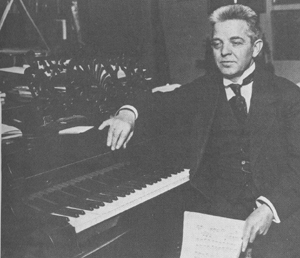
Carl Nielsen, 1865-1931
Carl Nielsen's piano works span his career as a composer, beginning with the Five Piano Pieces (1890) and concluding with the Piano Music for Young and Old (1930) written less than a year before his death. Nielsen wrote five major compositions for the instrument, each of considerable interpretive and technical difficulty. In addition he composed a number of smaller pieces, some of which have been used extensively for instructional purposes (see Table I).
TABLE I
PIANO COMPOSITIONS AND SYMPHONIES OF CARL NIELSEN
(1865-1931)
| Piano Works | Symphonic Works |
| 1882-83 | Two Character Pieces, unpublished | ||
| 1890 | Five Piano Pieces, Opus 3 | ||
| 1891-92 | Symphony No. 1, Opus 7 | ||
| 1894 | Symphonic Suite, Opus 8 | ||
| 1894-97 | Humoresque Bagatelles, Opus 11 | ||
| 1900 | Festival Prelude | ||
| 1901-02 | Symphony No. 2, Opus 16 | ||
| "The Four Temperaments" | |||
| 1905 | The Dream About | ||
| "Merry Christmas" | |||
| 1910-11 | Symphony No. 3, Opus 27 | ||
| "Sinfonia espansiva" | |||
| 1914-16 | Symphony No. 4, Opus 29 | ||
| "The Inextinguishable" | |||
| 1916 | Chaconne, Opus 32 | ||
| 1917 | Theme with Variations, Opus 40 | ||
| 1919-20 | Suite, Opus 45 | ||
| 1921-22 | Symphony No. 5, Opus 50 | ||
| 1924-25 | Symphony No. 6 | ||
| "Sinfonia semplice" | |||
| 1928 | Three Piano Pieces, Opus 59 | ||
| 1930 | Piano Music for Young and Old, | ||
| Opus 53, Two Volumes | |||
In contrast to many of his other works the piano music is relatively unknown and rarely performed outside of Denmark.1 This is unfortunate, particularly from a theoretical and aesthetic perspective, because the compositions can be viewed as a somewhat "ideal representation" of his musical expression. Nielsen was not a pianist and his piano works show little evidence of being influenced by an excessive concern with limitations of the idiom or of pianistic technique.2 This factor has broad theoretical implications in that figurations and patterns of tonality can be seen to represent "free composition," unencumbered by performance technicalities.3 Considered together, Nielsen's piano works reveal the development of a unique compositional style which provides evidence of his growing ability to understand and exploit the capacities of the keyboard.
While his piano compositions contain important examples of advanced and original harmonic techniques, Nielsen remained convinced throughout his life of the importance of simple intervals. He maintained that the study of intervals was vital to every musician as a means of preserving contact with musical origins.4 His own respect for these fundamental elements is exemplified in an often-quoted statement: "The glutted must be taught to regard a melodic third as a gift of God, a fourth as an experience, and a fifth as the supreme bliss."5 As a composer Nielsen made an extensive effort to exploit the potential of simple intervals for their musical expression. He has been quoted as saying, "The thing is to be able to use a pure fifth in such a way that no one thinks he has ever heard that interval before."6 This atavistic quality has been described as an important characteristic of Nielsen's compositional style.7
Although Nielsen's tonal language eventually included atonal and serial techniques, these were combined with and never totally replaced traditional tonal centers. While Nielsen strenuously objected to the classification of his music, his own writings present strong evidence that he never ceased to think of himself as a tonal composer. There are reasons to doubt that the progressive features of Nielsen's tonal language in the later piano works signified a deliberate attempt to follow modern trends. While several musical analysts of the time believed that Nielsen was deliberately attempting to follow new directions,8 Torben Meyer, Nielsen's most thorough biographer, offers evidence that Nielsen rarely worked consciously with theoretical problems.9 He cites a conversation in the late 1920s with Danish composer Hans Tørsleff in which Nielsen directly addressed the issue of self-conscious modernism in his compositional style: "Am I modern? Actually not, I think. How should I even be able to think that? At any rate, I have never made the slightest attempt to be modern, but have only written as I have had to write. . . ."10
In the earliest piano works (those before 1900), Nielsen's tonal language was highly chromatic, often in combination with modal characteristics. This harmonic approach is consistent in important respects with certain late nineteenth-century stylistic techniques. For example, the extensive use of chromaticism in the inner voices,11 chromatic inflection as a modulatory technique, and the use of chromatic mediant relations and modal harmony were evident in the music of Brahms and other romantic composers. Nevertheless other harmonic features emerge which are individual to Nielsen.
In the Symphonic Suite, for example, the extensive use of parallel modes is an important element of the tonal design of individual movements and of the work's chromaticism in general. The first movement begins in D Minor and ultimately cadences in D Major. In the second movement major and modal elements are manipulated to create momentary tonal ambiguity. In measures 1-8 the tonic key of F Major is not clearly established in the opening measures, and is even contradicted by the opening B-flat harmonization (Ex. 1).
Ex. 1: Theme of Movement Two, Symphonic Suite, measures 1-3.

A melodic analysis of the first segment of the theme shows F to be the structural pitch. The eighth- and sixteenth-note movement circling around F embellish it with neighboring tones and passing tones which ascend to its major and minor third. In each case, the embellishing tones gravitate back to their origin, F, establishing F as its tonic. At the same time, however, the parallel sixths accompanying the theme generate a harmonic setting of B-flat. A B-flat Mixolydian mode is suggested at first by the melodic ascent to A-flat. This juxtaposition of tonalities gives the movement a harmonically vague beginning and the tonal setting of F Major becomes clearer only as the phrase progresses.
In the work's third movement, frequent chromatic alteration of the interval of a third contributes Mixolydian harmony to the D Major tonality and serves in addition to enhance the passage's coloristic effects (Ex. 2).
Ex. 2: First Theme of Movement Three, Symphonic Suite, measures 1-3.

Nielsen's theme bears striking resemblance to the opening theme of the second movement of Brahms's Sonata in F Minor, Opus 5 (1854) in its melodic contour and in its sequences of descending and ascending thirds (Ex. 3).
Ex. 3: First Theme of Movement Two, J. Brahms, Sonata in F Minor, Opus 5, measures 1-5.

Whereas Brahms used parallel modes for thematic variation (antecedent phrase in A-flat Major, consequent phrase in A-flat Minor), Nielsen treated this alteration as a melodic motive. The chromatic alteration of the third appears in several forms throughout the movement's opening section and its return.
Nielsen's next three major works for the piano—the Chaconne, the Theme with Variations and the Suite—were composed between 1916 and 1920, and reflect a far more mature treatment of harmony and tonality than the earlier piano compositions. The harmonic language of these works is characterized by a subtle integration of whole-tone structures with functional major-minor and modal resources, by the juxtaposition of contrasting scales and key centers, and by the use of pedal points and ostinatos as independent harmonic resources. While these works continue to be based on tertian chordal structures, they contain expanded and more dissonant sonorities and make extensive use of melodic and harmonic semitonal movement. The compositions are marked by frequent cross relations, by areas of bitonality, and by extended passages with ambiguous and nonfunctional harmonic structures.
Expansive multi-level sonorities serve as an important vehicle for these harmonic techniques, especially where those techniques involve the use of pedal tones. In all of Nielsen's mature piano works, the pedal tone is often used to underline elements of tonal structure. In addition the pedal tone appears with increasing frequency as a dramatic device which serves to heighten musical tension.
The fifteenth, sixteenth and seventeenth variations of the Chaconne provide clear examples of this use of pedal tones and multi-level sonorities. The sixteenth variation, for example, contains three layers: the bass chaconne theme and two layers of treble chords (Ex. 4).
Ex. 4: Multi-Level Sonorities and Pedal Tones in the Sixteenth Variation, Chaconne, measures 1-3.

The rapid shifting of the treble chords, combined with the pedaling which is necessary to sustain the octaves of the chaconne theme in the bass, produces a cumulative dissonant effect.
The homophonic sonority of these three variations stands in notable contrast to the two-voice linear setting of the composition as a whole. This contrast is heightened by the dramatic tension created through the use of harmonic dissonance which does not resolve until the downbeat of the eighteenth variation. This dissonance is coupled with a double-dotted rhythmic pattern and set at a peak fff dynamic level.
In the fifteenth and final variation of the Theme with Variations, Nielsen makes similar use of pedal tones to intensify the effect of dissonant chords by obscuring changes in harmonic movement. This variation is also characterized by a technique which generates dissonance through the simultaneous use of two five-note figurations above a sustained bass chord (Ex. 5).
Ex. 5: Intensification of Dissonance by Pedal Tones, Variation XV, Theme with Variations, measures 17-18.
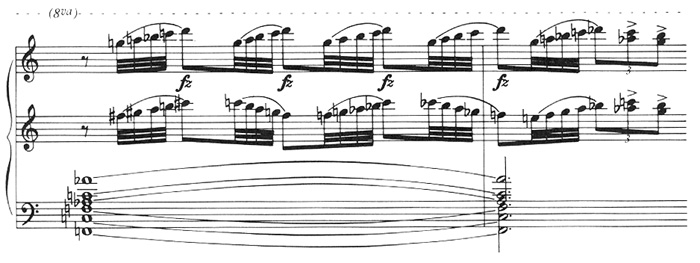
Here, for example, the right hand executes the five ascending tones of the G Minor scale while the left hand plays a figuration of alternately ascending and descending five-tone scales beginning on F-sharp. The juxtaposition of these scalar figurations creates momentary bitonality and linear dissonance and generates distinctive coloristic effects.12
Nielsen's use of pedal tones was not limited to the creation of these harmonic and dramatic effects. In the Symphonic Suite, Nielsen's earliest major piano work, sustained bass pedal tones served to expand the texture of extended passages containing moving treble chords in the upper voices. Here the pedal tones are framed in a functional diatonic setting and have the effect of simulating orchestral timbre.
Nielsen's use of pedal tones in the Chaconne and the Theme with Variations served in several instances to create and intensify areas of tonal ambiguity. In the Theme with Variations and in several later works the pedal tone also serves an opposite function of establishing and clarifying patterns of tonality. In these instances Nielsen's treatment of tonality shared an important technique with the impressionistic use of pedal to establish a tonal focus. Such an approach can be found in Variation XII of the Theme with Variations. This variation contains the work's sole departure from the theme's harmonic progression. However the variation is still linked to the theme by the pedal tones which appear at measures that correspond to their occurrence in the theme itself. These pedal tones, moreover, underline a tonal design identical to that of the theme—modulation from B Minor to C and finally to G Minor. The variation's rapid semitonal movement in the voices above the pedal tones creates clusters of seconds reminiscent of impressionistic sonority (Ex. 6).
Ex. 6: Semitonal Movement and Pedal Tones in Variation XII, Theme with Variations, measure 1.
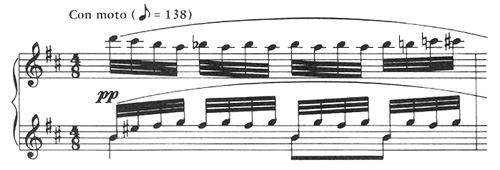
Nielsen's incorporation of impressionistic devices in his approach to harmony becomes even more striking in the Suite and in the Three Piano Pieces. In the second movement of the Suite Nielsen uses whole-tone scales, tone clusters and parallel harmonies. Unlike the Impressionists, however, Nielsen continued to emphasize linear movement and melodic voice-leading. Nielsen's compositional style in general was characterized by a clarity of linear-contrapuntal movement within homophonic textures, and this feature becomes especially important in the impressionistic passages of this movement.
Nielsen continually expanded his harmonic language, but his harmonic technique never ceased to incorporate or ultimately return to a traditional tonal framework. The Suite, for example, contains more intense and sustained dissonance than any of Nielsen's earlier piano works. It is generated by polytonality and by dissonant intervallic and harmonic structures, and reflects the work's chromaticism and profusion of linear activity. Throughout the Suite dissonance invariably resolves to harmonic consonance.
The dissonant tritone interval is a central element of the first movement, where it appears in the second theme and becomes an important thematic element for the first time in Nielsen's piano works. The interval is treated far more conservatively by Nielsen than by composers who used its melodic and harmonic instabilities to dissolve a tonal framework. In the Suite Nielsen's use of the tritone serves to reinforce rather than to destroy tonal links. The tritone A—D-sharp, for example, occurs within a tonal setting of A (Ex. 7).
Ex. 7: Use of Tritone in a Tonic-Dominant Relationship in Movement One, Suite, measures 21-22.

Because D-sharp is the leading tone to the key's dominant center of E, the tritone serves to strengthen a conventional tonic-dominant relationship.13
Even in the Suite's most dissonant structures, the work's harmonic roots are still apparent. In the coda of the work all but two tones of the twelve-tone scale appear in two adjacent chords (Ex. 8).
Ex. 8: Dissonance Within a Tonic-Dominant Relationship in Movement Six, Suite, measures 271-274.

Despite the ease with which such a chordal succession might obliterate tonality, the passage's B-flat pedal tone creates a tonal center in which changing dissonant structures can be heard in a tonic-dominant relationship.
The Three Piano Pieces was Nielsen's last major piano work and one of his final important compositions.14 Originally titled "Three Impromptus,"15 the work uses impressionistic, polytonal and atonal techniques in different sections. The composition is the most stylistically progressive of Nielsen's piano works, and contains the only instance of twelve-tone serial composition in his keyboard writing.
While the Three Piano Pieces contains new harmonic techniques, the work is clearly rooted in the approaches which Nielsen began to explore in his earlier piano compositions. The first piece contains four sections, each set apart by its separate and internally consistent pattern of tonal organization. The first and third sections are thematically similar, and are impressionistic in their whole-tone chordal formations and their emphases on parallel motion. However these harmonic resources are treated classically in several respects. Note in Ex. 9 the symmetry of the piece's phrase structure, and the arching of the melodic line which reinforces the cadential tones of B and A-sharp.
Ex. 9: B-Minor Focus of Melodic Movement of Lower Voice in First Piece, Three Piano Pieces, measures 1-4.
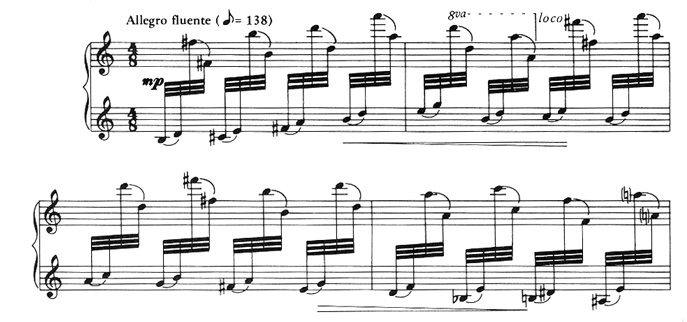
These features, and the recurring B Minor sonorities which are made prominent by the melodic movement of the lower voice, contribute to the retention of a B Minor tonal center despite the passage's emphasis on the interval of the perfect fourth.
The second of the Three Piano Pieces is only 16 measures in length. Here, as he often did in his early works, Nielsen creates striking effects by juxtaposing the elements of different harmonic systems. Earlier, in the Symphonic Suite, Nielsen juxtaposed major and modal characteristics. (See Exs. 1 and 2.) In the second of the Three Piano Pieces, Nielsen combines these elements and whole-tone characteristics as well.
The piece opens with strongly-accented dissonant chords. It derives an improvisatory character from the alternation of chorale-like textures, repeating a simple I-IV-I harmonic progression and harmonically and texturally complex episodic sequences. In the first of these sequences Nielsen juxtaposes minor, modal and whole-tone resources. Melodic movement in the treble is built on F-sharp melodic minor and Mixolydian scales, and is accompanied by minor sixths in the bass. The sixths, combined with the treble tones, create whole-tone chords.
Ex. 10: Juxtaposition of Minor, Modal and Whole-Tone Resources in Second Piece, Three Piano Pieces, measure 7.

The last of the Three Piano Pieces is also characterized by the juxtaposition of contrasting tonal approaches. This piece in addition contains a fugato which is notable for its use of twelve-tone serial technique. All twelve tones appear in the statement of the subject, and ten of the twelve tones are present in the countersubject (Ex. 11).
Ex. 11: Serial Technique in Fugal Subject and Countersubject in Third Piece, Three Piano Pieces, measures 90-97.
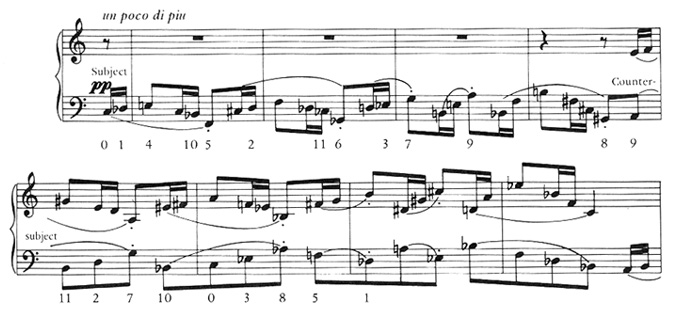
Serial technique is not applied in a strict manner, however. Tones of the row are frequently repeated, within the subject.
Nielsen's treatment of serialism is highly unusual in its arrangement of the twelve-tone row in tonal groupings. Frede Schandorf Petersen, in his cogent analysis of the piece, pointed to Nielsen's use of two hexachords, each divided into two internally consonant triadic groups.16
Ex. 12: Division of Whole-Tone Complexes into Triadic Groups.
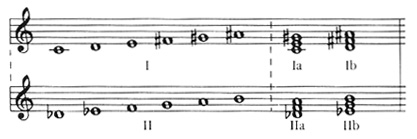
Each triadic group appears in various linear and harmonic contexts, with melodic and intervallic tension frequently resulting from the juxtaposition of different groups. Intervallic tension is generated by phrasings which in several cases combine triads from different tone complexes. Even more than the composition's first two pieces, the third piece contains unconventional harmonic techniques and varied combinations of these techniques with more traditional tonal and modal structures.
In the consideration of Nielsen's piano works as a whole, several broad patterns emerge. These piano works—both within their sections and movements and in their overall design—are characterized by a strong tonal coherence. Tonal patterns are clearly articulated, and are closely and consistently linked to structural intervallic and melodic patterns and to different types of harmonic structure.
This coherence, and distinctive features in Nielsen's treatment of tonality, are not limited to his piano works but characterize Nielsen's compositional style in general. His treatment of tonality has been considered by many to be highly innovative, and has been the primary focus of much of the limited Nielsen research which exists at this time.17
Two theories have been used to explain Nielsen's treatment of tonality, in which works frequently conclude in keys other than those in which they began. Robert Simpson, the British composer and musicologist, coined the term "progressive tonality" and applied it to Nielsen's music. According to Simpson, Nielsen "developed a dynamic view of tonality; most of his mature works treat a chosen key as a goal to be achieved or an order to be evolved."18 Simpson's concept of progressive tonality, although vaguely defined, has entered into subsequent analyses of Nielsen's music.
Graham George questioned the adequacy of Simpson's theory of progressive tonality, and argued for a concept of interlocking tonal structures to explain specific relationships between key centers. Interlocking structures, for George, were those "in which two 'closed' structures on different tonal centers overlap so that the total structure ends in a key other than that in which it began."19 George thus offered a more static explanation of Nielsen's tonal technique, but did provide a concept capable of examining more specifically the precise tonal relationships within a given work. George's concept of interlocking tonal structures is not simply a rebuttal of Simpson's theory of progressive tonality, but can also be seen as an analytic approach in which Simpson's concepts can be operationally defined.
In summary, an examination of Nielsen's piano music reveals those works to be highly individual in their combinations of traditional and progressive harmonic techniques. While Nielsen employed a range of practices which emerged from the stylistic movements of his lifetime, his personal adaptation of these practices is highly consistent with his own expressed wish not to be classified within any single stylistic school—modernist or otherwise. Indeed, Nielsen's approach to harmony and tonality, combining and adapting elements from various sources, makes it difficult and probably inappropriate to classify his works within the categories suggested by the schools which influenced compositional practice during his lifetime. If Nielsen's works appear eclectic in their tonal and harmonic design, this fact is probably due not to a self-conscious eclecticism on Nielsen's part, but rather to an approach in which diverse elements were molded in an individual way in an attempt to express his own musical ideas as clearly and directly as possible.
Excerpts from Carl Nielsen's piano music quoted by permission of the copyright owners, Edition Wilhelm Hansen, Copenhagen, and Samfundet til udgivelse af Dansk Musik, Copenhagen.
1The author of this article gave what she believes to have been the American premieres of several of Nielsen's piano works in recitals at New York University. The Humoresque Bagatelles, Opus 11 were included in a recital on May 22, 1975; a recital on May 27, 1976, devoted entirely to Nielsen's piano music, included the Chaconne, Opus 32, the Theme with Variations, Opus 40, the Suite, Opus 45 and the Three Piano Pieces, Opus 59. These performances were the American premières of all except the Opus 40, which was performed in 1971 by Gabriel Di Piazza in a lecture-recital at North Texas State University.
Most existing phonograph recordings of Nielsen's piano works were made by Scandinavian pianists. These include the Danish performers Arne Skjold Rasmussen, Herman D. Koppel and Eyvind Møller. Recordings have also been made by British pianists John Ogdon and John McCabe.
2While Nielsen was not an accomplished pianist, neither was he a novice at the instrument. He used the piano extensively when composing and possessed sufficient ability to play Bach's Well Tempered Clavier.
3The close relationship between compositional style and performance technique has often been used to explain the individual features and the sheer "pianism" in works of composer-pianists. However this relationship can also affect other levels of musical structure. Edward T. Cone for example sees this factor as a possible explanation for idiosyncratic key relations in Chopin's piano concertos. Musical Form and Musical Performance (New York: W.W. Norton & Co., Inc., 1968), p. 86.
4Carl Nielsen, Living Music, translated by Reginald Spink (Copenhagen: Wilhelm Hansen, 1953), p. 42.
5Ibid.
6Carl Nielsen as cited in Knud Jeppesen, "Carl Nielsen," Music Review, Vol. 7, No. 3 (1946), p. 174.
7Knud Jeppesen, "Carl Nielsen," Dansk Biografisk Lexsikon, ed. Povl Engelstoft and Svend Dahl (Copenhagen: J.H. Schultz, 1939), XVII, 37 and Torben Schousboe, "Carl Nielsen," The New Grove Dictionary of Music and Musicians.
8Torben Meyer and Frede Schandorf Petersen, Carl Nielsen: Kunstneren og Mennesket (Copenhagen: Nyt Nordisk Forlag, 1948), II, 271.
9Meyer cites Nielsen's reaction to an analysis by Povl Hamburger of the Third Symphony as evidence that the composer was indifferent to theoretical or analytical implications drawn by others, Ibid.
10Idem., p. 281. English translation by the author of this article.
11Torben Schousboe attributes Nielsen's increasing use of chromaticism in the middle voices to his own performing experience (as second violinist) in Wagner's operas. "Carl Nielsen," The New Grove.
12Such five-note figurations, often emphasized by "sforzando" markings, frequently appear in Nielsen's piano works, and occur 36 times in this variation alone.
13Four years earlier Nielsen's similar use of the tritone served to generate dissonance while preserving tonality in the Fourth Symphony, Opus 29.
14After completing the Suite and before the Three Piano Pieces, Nielsen composed the Fifth Symphony (1921-22), the Wind Quintet (1922), the Sixth Symphony (1924-25) and the Flute Concerto (1926).
15Meyer and Petersen, II, 265.
16These complexes were identified by Frede Schandorf Petersen in his analysis of the work. Idem., pp. 268-270.
17Of the four completed dissertations on Nielsen's music, three deal with aspects of his treatment of tonality: (1) William I. Jones, Jr., A Study of Tonality in the Symphonies of Carl Nielsen (Dissertation, Florida State University, 1973); (2) Mina F. Miller, The Solo Piano Music of Carl Nielsen: An Analysis for Performance (Dissertation, New York University, 1978); and (3) Dean Wilson, An Analytical and Statistical Study of the Harmony in Carl Nielsen's Six Symphonies (Dissertation, Michigan State University, 1968).
18Robert Simpson, Carl Nielsen: Symphonist (London: J.M. Dent & Sons, 1952), p. 5. Simpson restates this proposition in a second edition: Carl Nielsen: Symphonist (New York: Taplinger, 1979), p. 21.
19Graham George, Tonality and Musical Structure (New York and Washington: Praeger, 1970), p. 29.


